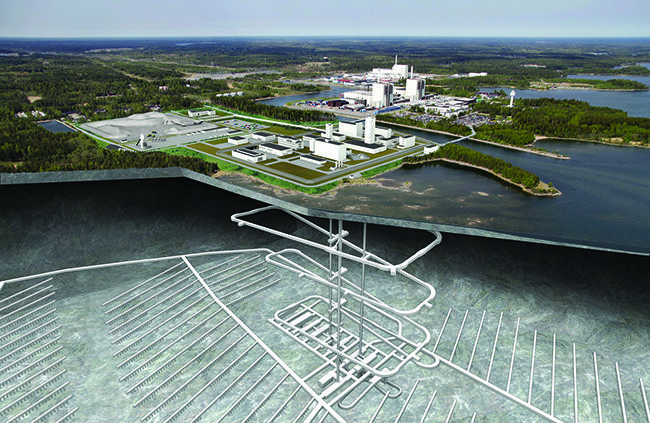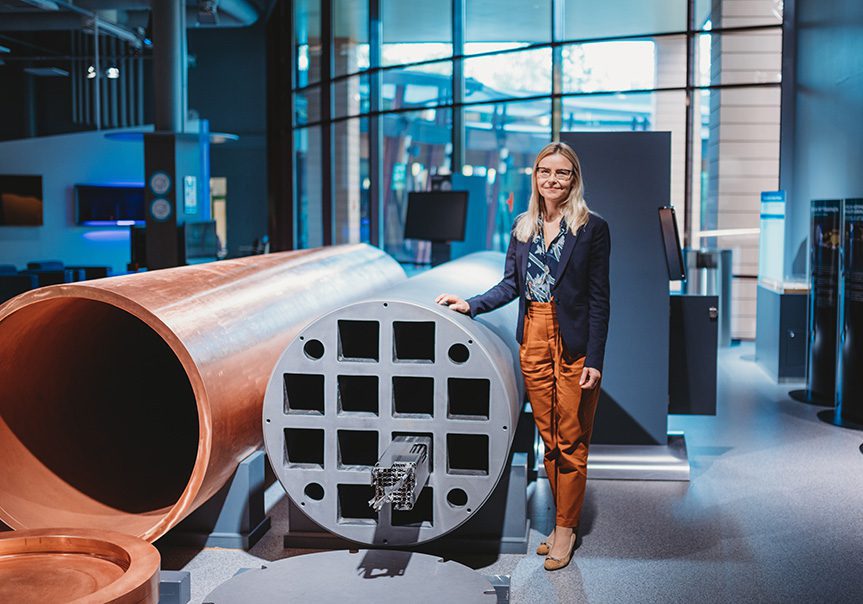Sweden’s Government Approves Construction of Spent Nuclear Fuel Repository

Sweden's government in late January gave radioactive waste management company Svensk Karnbranslehantering AB (SKB) the green light to proceed with a deep geological repository (DGR) for spent nuclear fuel (SNF) at a site near Vattenfall's 3.2-GW Forsmark nuclear power plant.
The milestone, which wraps up a planning process that has taken more than 40 years, makes Sweden only the second country, after Finland, to take active steps on building a permanent SNF repository.
SKB, a company established in the 1970s by Sweden's nuclear generators, will now seek permits from the Land and Environment Court and Swedish Radiation Safety Authority. The entities are expected to establish conditions" for the $2 billion (SEK 19 billion) integrated facility, which will comprise a DGR at Forsmark in Osthammar municipality and an encapsulation plant next to an interim storage facility in Clab, outside Oskarshamn municipality.
Clab today contains about 6,500 tonnes of SNF, and SKB has suggested that by the time Sweden's 12 nuclear reactors are retired, its SNF storage needs will rise to accommodate 12,000 tonnes.
A Complex EndeavorSKB envisions that when the DGR is fully developed" at Soderviken (within Forsmark's industrial zone) sometime in the 2080s," it will include 60 kilometers of tunnels with room for 6,000 copper canisters holding up to 12,000 tonnes of SNF. The total volume of the space required underground in the rock will be about four square kilometers," SKB said. The project also envisions an expansion of capacity at Clab from 8,000 tonnes of SNF to 11,000 tonnes.
 |
1. This photo montage shows the final deep geological repository for 12,000 tonnes of spent nuclear fuel in Forsmark, in Sweden. The total length of the tunnel system is more than 60 kilometers. Below ground, the repository covers three to four square kilometers at a depth of 500 meters. Courtesy: SKB |
The DGR's construction will consist of two parts: an operations area on the ground surface and a deposition area below ground (Figure 1). The underground facility will require boring several tunnels, 300 meters in length, to depths of up to 500 meters. Eight-meter-deep deposition holes are bored at intervals of six meters in the tunnel floors," SKB said.
The facility will use SKB's developed KBS-3 containment method. The canisters, each 5-meters-long and weighing up to 27 tonnes, will comprise a copper shell and an insert of nodular iron. Canisters will be deposited in deposition holes surrounded by the bentonite buffer, and bedrock.
Construction of the tunnel system and deposition of canisters in the Spent Fuel Repository will proceed in parallel over a period of many years in separate operation areas. When all deposition holes in a deposition tunnel are full, the tunnel is backfilled with clay. Finally, when all canisters have been deposited, the entire repository is backfilled," SKB said. However, Only when all licenses are in place can construction start, after which time, it will take about 10 years to build the spent fuel repository," it noted.
Decades of DevelopmentThe government's approval stems from efforts kicked off in 1977 with geological surveys of Sweden's bedrock. In 1992, a site selection process was initiated via a voluntary response approach. In 2009, after five years of site investigations, SKB selected Forsmark, submitting a license application for the proposed site and the KBS-3 containment method to the government in 2011. More notable milestones came in January 2018 and October 2020, when the municipalities of Oskarshamn and Osthammar voted to approve the repository.
Sweden's nuclear generators have underscored the urgency to build the DGR. In May 2021, they reportedly posted an urgent message via power exchange Nord Pool that the Clab interim facility was reaching full capacity. Sweden's nuclear fleet currently includes six operating reactors, which generate nearly 30% of the country's power. State-owned utility Vattenfall co-owns five units, including Forsmark 1, 2, and 3, and Ringhals 3 and 4, while Oskarshamns Kraftgrupp (OKG) owns the sixth, Oskarshamn-3. While Vattenfall says it has invested in extensive" modernization programs and expects its reactors are well-prepared to operate for decades ahead," it warned last May that without a long-term disposal solution, Forsmark 4 reactor faces potential closure in 2024, followed by Forsmark 3 and Ringhals 3 and 4 the next year, with Forsmark 1 in 2028.
Solna-headquartered SKB, notably, is majority held by Vattenfall (36%), followed by Forsmarks Kraftgrupp (30%), OKG (22%), and Sydkraft Nuclear Power (12%). In a statement to POWER in January, SKB Managing Director Johan Dasht hailed the project as a potentially pioneering opportunity for the long-standing SNF disposal issue. For SKB, the decision further strengthens our position as a world leader in this area," he said.
 |
2. Teollisuuden Voima Oyj (TVO), operator of the two-unit 3.4-GW Olkiluoto nuclear power plant, is readying to start up Olkiluoto 3 at the end of February. When the long-delayed 1.6-GW EPR reactor officially begins operation in July 2022, the island of Olkiluoto will generate about 30% of Finland's power. Courtesy: TVO |
According to Washington, D.C.-based Stimson Center, a nonprofit committed to international security, and which painstakingly monitors global SNF disposal, of 21 countries that have significant nuclear power activities and spent fuel management policies, five countries-Canada, Finland, France, Sweden, and Switzerland-are the most advanced in moving forward with deep geological disposal in the next decades."
Still, Finland is notably the only country already building a DGR, kicking off construction of its Onkalo facility in Olkiluoto (Figure 2), off the southwestern coast of Finland in 2016. Finland expects to begin operating the facility in 2025. Onkalo, too, will use SKB's KBS-3 disposal concept to store SNF up to 450 meters underground at a site that was chosen by Posiva, SKB's Finnish counterpart, and licensed in 2015-marking the first time a construction license for a geological disposal facility was received anywhere in the world.
Posiva, which in late December submitted an operating license for its integrated DGR and encapsulation facility, in January notably announced that it is readying to conduct a trial run of final disposal (TRFD) in 2023. The TRFD comprises the whole disposal process with final disposal systems and machinery, organisation and procedures, but will be performed with dummy fuel assemblies," the company told POWER.
Tiina Jalonen, senior vice president of Development for Posiva suggested the key to development of final disposal is the long-term safety of the solution," which must be assessed and demonstrated with the safety case." The safety case encapsulates every aspect of investigation, including all technological and scientific materials, analyses, observations, trials, tests, and other proof used to justify the reliability of the assessments made of the long-term safety of final disposal. The more than four decades of research work is transformed into a detailed description of the geological final disposal solution, analysing different evolutionary paths and demonstrating the safety of final disposal in the conditions of Olkiluoto bedrock," she said.
 3. Tiina Jalonen, senior vice president of Development, for Posiva, Finland's developer of a final spent nuclear fuel disposal facility, stands beside a copper canister that has been designed to act mainly as a corrosion barrier for the cast iron inner part, which in turn contains the fuel elements. Courtesy: Posiva
3. Tiina Jalonen, senior vice president of Development, for Posiva, Finland's developer of a final spent nuclear fuel disposal facility, stands beside a copper canister that has been designed to act mainly as a corrosion barrier for the cast iron inner part, which in turn contains the fuel elements. Courtesy: Posiva
According to the Stimson Center, like Finland and Sweden, Canada, France, and Switzerland are making headway in this respect. In France, radioactive waste management agency Andra is currently preparing a license application for its planned DGR, Cigeo," with construction slated to begin as early as 2023. In Canada and Switzerland national waste management agencies are investigating appropriate sites through site characterization.
As of 2021, meanwhile, nine countries-Belgium, Czech Republic, Finland, France, Germany, Japan, South Korea, Sweden, and Switzerland-had underground research laboratories (URLs), of which three URLs (in Finland, France, and Germany) are site-specific. China, meanwhile, is currently constructing a site-specific URL in Gansu Province.
Stimson suggests that trust"-the perceived credibility and legitimacy of an active body-is imperative to gain a much-needed social license to operate" (SLO). Finland and Sweden have so far found success in communicating trust and safety to communities already closely involved with the nuclear fuel cycle, it said. In the 5 countries with the most advanced DGR plans, community engagement is a long-term and dedicated effort that has continued for decades based on the understanding that public acceptance is critical for the success of such facilities," Stimson added. The public has been involved in many parts of the repository disposal plans, especially those using community-driven, consent-based siting processes."
-Sonal Patelis a POWER senior associate editor (@sonalcpatel,@POWERmagazine).
The post Sweden's Government Approves Construction of Spent Nuclear Fuel Repository appeared first on POWER Magazine.